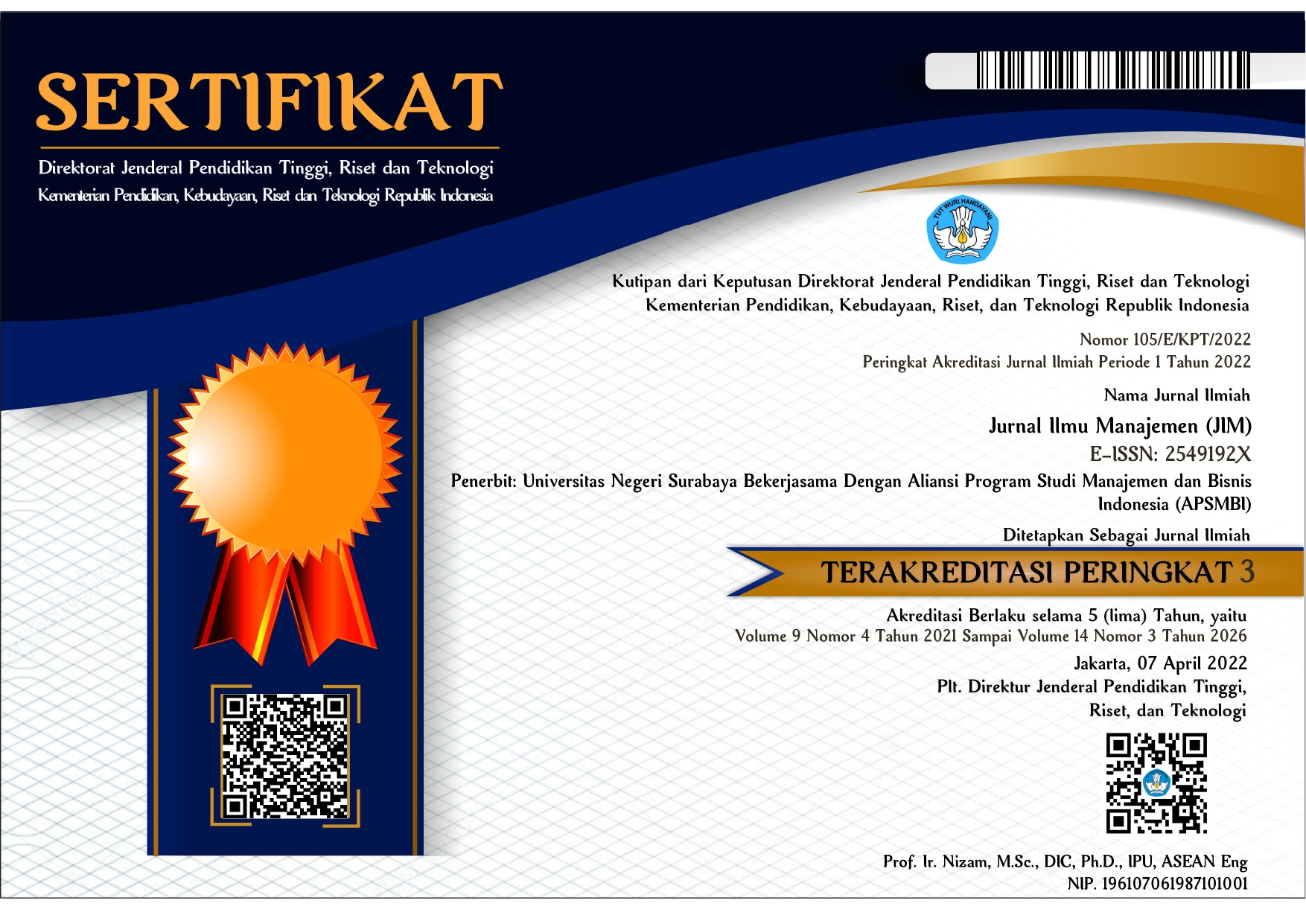Pengaruh foreign debt, exchange rate, growth opportunity, firm size, liquidity, dan profitability terhadap hedging decision pada perusahaan sektor energi di BEI periode 2019-2023
DOI:
https://doi.org/10.26740/jim.v13n2.p417-433Keywords:
firm size, foreign debt, growth opportunity, hedging, liquidityAbstract
Participation in international transactions inherently exposes companies to risks, particularly those arising from exchange rate fluctuations. Therefore, it is essential for companies to manage these risks through preventive measures such as hedging, which serves as a strategic tool to mitigate and minimize potential financial losses. This study aims to determine the effect of foreign debt, exchange rate, growth opportunity, firm size, liquidity, and profitability on hedging decisions in energy sector companies listed on the IDX from 2019 to 2023. The population of this study consists of 90 energy sector companies listed on the IDX. The sample used comprises 39 companies, selected through purposive sampling techniques. The data is processed using IBM SPSS 25 with logistic regression analysis technique. The results of this study indicate that foreign debt and firm size positively affect hedging decisions, while liquidity negatively affects hedging decisions. Whereas, exchange rate, growth opportunity, and profitability show no significant effect on hedging decisions. Given these findings, energy sector companies are advised to prioritize factors that significantly influence hedging decisions, particularly foreign debt, firm size, and liquidity. By incorporating these considerations into their financial strategies, companies can improve decision-making accuracy, safeguard cash flow, and enhance financial stability.
References
Ahmad, B., Siregar, H., Sembel, R., & Irawan, T. (2023). Analysis of hedging for mitigating exchange rate fluctuations in indonesia, with a logistic regression approach (empirical study of consumer cyclical companies). Journal of Advanced Zoology , 44(4), 805–814. https://doi.org/DOI:10.17762/jaz.v44i4.1153
Álvarez-Díez, S., Alfaro-Cid, E., & Fernández-Blanco, M. O. (2016). Hedging foreign exchange rate risk: Multi-currency diversification. European Journal of Management and Business Economics, 25(1), 2–7. https://doi.org/10.1016/j.redee.2015.11.003
Aritonang, E. W. R. B., Christina Daat, S., & Noor Andriati, H. (2018). Faktor-faktor dalam pengambilan keputusan lindung nilai (hedging) pada instrumen derivatif valuta asing pada perusahaan yang terdaftar di Bursa Efek Indonesia. Jurnal Akuntansi & Keuangan Daerah, 13(1), 96–113. https://doi.org/https://doi.org/10.52062/jakd.v13i1.1428
Asfrianto, F. R., Saleh, S., Syaifuddin, D. T., Sujono, S., & Hamid, W. (2023). Pengaruh leverage, likuiditas, growth opportunity, firm size dan profitabilitas terhadap keputusan hedging (studi pada sektor consumer non-cyclicals yang tercatat di Bursa Efek Indonesia tahun 2017-2021). Urnal Manajemen, Bisnis Dan Organisasi (JUMBO), 7(3), 586–599. https://doi.org/https://doi.org/10.33772/jumbo.v7i3.615
Bessler, W., Conlon, T., & Huan, X. (2019). Does corporate hedging enhance shareholder value? A meta-analysis. International Review of Financial Analysis, 61, 222–232. https://doi.org/10.1016/j.irfa.2018.11.010
Brealey, R., Myers, S., & Marcus, A. (2009). Fundamentals of corporate finance: 6th (sixth) edition (R. Brealey, S. Myers, & A. Marcus, Eds.). McGraw-Hill .
Brigham, E. F., & Houston, J. F. (2018). Essentials of financial management (fourth). Cengage Learning Asia Pte Ltd.
Buyukkara, G., Baha Karan, M., Temiz, H., & Yildiz, Y. (2019). Exchange rate risk and corporate hedging: evidence from Turkey. Emerging Markets Finance and Trade, 55(8), 1737–1753. https://doi.org/10.1080/1540496X.2018.1490262
Condronegoro, A., & Hasibuan, H. T. (2023). Leverage, firm size, likuiditas, financial distress, dan aktivitas hedging dengan instrumen derivatif. E-Jurnal Akuntansi, 33(8). https://doi.org/10.24843/eja.2023.v33.i08.p10
Danila, N., & Huang, C. H. (2016). The determinants of exchange rate risk management in developing countries: Evidence from Indonesia. Afro-Asian Journal of Finance and Accounting, 6(1), 53–67. https://doi.org/10.1504/AAJFA.2016.074552
Duc, H., Quang, N., Huong, N., Duc Le, H., Quang Viet, N., & Huaong Anh, N. (2021). Trade-off theory and pecking order theory: evidence from real estate companies in Vietnam. Economics and Business Quarterly Reviews , 79–94. https://doi.org/10.31014/aior.1992.04.02.347
Fajri, M. B., Putro, G. M. H., Bait, J. F., & Megasyara, I. (2023). What factors affect hedging? empirical evidance from Indonesia. MEC-J (Management and Economics Journal), 7(1), 21–42. https://doi.org/10.18860/mec-j.v7i1.19277
Guniarti, F. (2014). Faktor-faktor yang mempengaruhi aktivitas hedging dengan instrumen derivatif valuta asing the factors wich influence the hedging activities with foreign currency derivative instrumen. Jurnal Dinamika Manajemen , 5(1), 64–79. https://doi.org/Https://Doi.Org/10.15294/Jdm.V5i1.3651
Hadini, C. R., & Desmiza, D. (2024). Pengaruh cash flow volatility, firm size, foreign debt dan exchange rate terhadap hedging (studi pada perusahaan sektor energi tahun 2018-2022). J-MAS (Jurnal Manajemen Dan Sains), 9(1), 660. https://doi.org/10.33087/jmas.v9i1.1769
Handayani, S., & Airawaty, D. (2024). The influence of firm size, leverage and profitability on hedging decisions in companies registered consumption goods industry on BEI for the 2021-2022 Period. Journal of Economic Development and Village Building, 2(1), 1–9. https://doi.org/https://doi.org/10.59261/jedvb.v2i1.11
Hendartyo, M. (2022). Rupiah terdepresiasi 4,27 persen, BI: lebih baik dibandingkan sejumlah negara berkembang. Tempo.Com. https://www.tempo.co/ekonomi/rupiah-terdepresiasi-4-27-persen-bi-lebih-baik-dibandingkan-sejumlah-negara-berkembang-302779
Hidayah, N., & Prasetiono. (2016). Faktor penentu perusahaan melakukan pengambilan keputusan hedging pada derivatif valuta asing. Diponegoro Journal Of Management, 5(3), 1–13. https://doi.org/http://ejournal-s1.undip.ac.id/index.php/management
Hosama, E., & Setyawan, I. R. (2022). Determinants of hedging decisions in State-Owned and Private Manufacturing Firms on the IDX. Journal of Economics, Finance and Management Studies, 5(1), 3157–3164. https://doi.org/10.47191/jefms/v5-i11-05
Junior, J. L. R. (2013). Hedging, selective hedging, or speculation? Evidence of the use of derivatives by Brazilian firms during the financial crisis. Journal of Multinational Financial Management, 23(5), 415–433. https://doi.org/10.1016/j.mulfin.2013.08.004
Kahneman, D., & Tversky’, A. (1979). Prospect theory: An analysis of decision under risk. Econometrica, 47(2), 263–291.
Karlinda, M. P. B., & Manunggal, S. A. M. (2023). Pengaruh leverage, firm size, profitabilitas, dan likuiditas terhadap pengambilan keputusan hedging perusahaan manufaktur di BEI. Jurnal Manajemen Bisnis Dan Kewirausahaan, 7(2), 467–480. https://doi.org/https://doi.org/10.24912/jmbk.v7i2.23104
Kementerian Keuangan dan Bank Indonesia. (2024). Statistik Utang Luar Negeri Indonesia (SULNI). https://www.bi.go.id/en/statistik/ekonomi-keuangan/sulni/Documents/SULNI-August-2024.pdf
Kim, S. S., Chung, J., Hwang, J. H., & Pyun, J. H. (2020). The effectiveness of foreign debt in hedging exchange rate exposure: Multinational enterprises vs. exporting firms. Pacific Basin Finance Journal, 64, 1–40. https://doi.org/10.1016/j.pacfin.2020.101455
Kinasih, R., & Mahardika, D. P. K. (2019). Pengaruh likuiditas, leverage, dan nilai tukar rupiah terhadap penggunaan instrumen derivatif sebagai keputusan hedging. Jurnal Ilmiah Manajemen, Ekonomi, & Akuntansi (MEA), 3(1), 63–80. https://doi.org/https://doi.org/10.31955/mea.v3i1.100
Kurniawan. (2019). Analisis data menggunakan stata se 14 (panduan analisis, langkah lebih cepat, lebih mudah dan paling praktis). Deepublish Publisher.
Madura, J. (2018). International Financial Management 13th Edition. Cengage Learning.
Meridelima, E., & Isbanah, Y. (2021). Analisis faktor-faktor yang memengaruhi keputusan hedging perusahaan sektor industri pengolahan yang terdaftar di BEI Tahun 2014-2018. Jurnal Ilmu Manajemen, 9(1), 112–128. https://doi.org/https://doi.org/10.26740/jim.v9n1.p112-128
Mirdha, A., Arfan, M., & Indayani. (2023). Mengapa perusahaan manufaktur di indonesia melakukan keputusan hedging? Jurnal Reviu Akuntansi Dan Keuangan, 13(1). https://doi.org/10.22219/jrak.v13i1.21659
Modigliani, F., & Miller, M. H. (1958). The cost of capital, corporation finance and the theory of investment. The American Economic Review, 48(3), 261–297. https://doi.org/http://www.jstor.org/stable/1809766
Mubarok, F., & Utami, R. N. (2020). Panel method in hedging: evidence from The Indonesian Agricultural Sector. Jurnal Dinamika Akuntansi, 12(2), 165–177. https://doi.org/10.15294/jda.v12i2.24676
Myers, S. C. (1984). The capital structure puzzle. The Journal of Finance, 39(3), 574–592. https://doi.org/10.1111/j.1540-6261.1984.tb03646.x
Nabiilah, I. A. (2021). Determinasi keputusan hedging perusahaan publik sektor pertanian 2013-2019. Jurnal Ilmu Manajemen, 9(2), 386–398. https://doi.org/https://doi.org/10.26740/jim.v9n2.p386-398
Nurmalasari, M. R., Prawitasari, P. P., Kusnita, K. L., Yani, N. W. M. N., & Krismajayanti, N. P. A. (2024). Profitability and liquidity on hedging decision during Covid-19 pandemic. Lecture Notes in Networks and Systems, 924 LNNS, 446–453. https://doi.org/10.1007/978-3-031-53998-5_39
Pangestuti, D. C., Fadila, A., & Nugraheni, S. (2020). Analisis regresi logistik : faktor — faktor yang mempengaruhi keputusan hedging menggunakan instrumen derivatif. Jurnal ASET (Akuntansi Riset), 12(2), 227–240. https://doi.org/10.17509/jaset.v12i2.25420
Prihadi, T. (2019). Analisis laporan keuangan konsep & aplikasi. PT Gramedia Pustaka Utama.
Raharjo, B. (2022). Analisa laporan keuangan. Yayasan Prima Agus Teknik.
Rahmadini, M., & Darminto, D. P. (2020). Struktur modal dan determinasi keputusan hedging pada perusahaan automotive and allied products. Jurnal Riset Akuntansi Dan Perpajakan), 7(1), 35–42. https://doi.org/DOI:10.35838/jrap.2020.007.01.4
Salsabila, A. R., Purti, W. R. E., Septiyanti, R., & Sembiring, S. I. O. (2023). The association of exchange rate, foreign debt, and bankruptcy risk on hedging decisions during the pandemic. INVEST : Jurnal Inovasi Bisnis Dan Akuntansi, 4(1), 2745–4614. https://doi.org/https://doi.org/10.55583/invest.v4i2.499
Setiawan, I. G. A. N. A. P., & Mahardika, D. P. K. (2019). Analisis pengaruh market to book value, firm size dan profitabilitas terhadap pengambilan keputusan lindung nilai. Jurnal Ilmiah Akuntansi, 4(1), 124–140. https://doi.org/https://doi.org/10.23887/jia.v4i1.17055
Shapiro, A. C. . (2014). Multinational financial management. Wiley.
Sitorus, T., Pardede, R., & Ardi. (2019). The influence of liquidity and profitability toward share price: Mediated effect of hedging (evidences from shares of LQ-45 listed in indonesian stock exchange for period of 2011 to 2015). Humanities and Social Sciences Reviews, 7(5), 150–160. https://doi.org/10.18510/hssr.2019.7519
Sudiarta, B. H., & Setyawan, I. R. (2022). Determining factors of hedging decisions in Indonesia stock exchange. Jurnal Muara Ilmu Ekonomi Dan Bisnis, 6(1), 95. https://doi.org/10.24912/jmieb.v6i1.11909
Tang, H. (2024). The situation in the middle east from the perspective of prospect theory: “hedging” or “speculating”“speculating.” Advances in Politics and Economics, 7(2), p29. https://doi.org/10.22158/ape.v7n2p29
Titman, S., Keown, A. J., & Martin, J. D. (2018). Financial management: principles and applications. Pearson Education.
Turner, G. (2011). Effective financial management the cornerstone to success. Business Expert Press, LCC.
Verawaty, Jaya, A. K., & Megawati. (2020). Determinan pengambilan keputusan lindung nilai (hedging) dengan instrumen derivatif valuta asing pada perusahaan manufaktur. Akuisisi: Jurnal Akuntansi, 15(1), 9–26. https://doi.org/https://Doi.Org/10.24127/Akuisisi.V15i1.281
Wahyudi, S., Goklas, F., Rita, M. R., Hersugondo, H., & Laksana, R. D. (2019). The determinants of corporate hedging policy: a case study from Indonesia. International Journal of Economics and Business Administration, VII(1), 113–129. https://doi.org/10.35808/ijeba/199
Wijayani, D. R., & Harsanti, P. (2020). Determinant of hedging activities in soe companies listed in Indonesia Stock Exchange Period 2015-2019. Jurnal Riset Akuntansi Dan Bisnis Airlangga , 5(1), 800–817. https://doi.org/https://doi.org/10.20473/jraba.v5i1.46034
Yudha, J. O. M., Oktavia, R., & Desriani, N. (2022). Does the growth opportunities have an impact on hedging decision from own-stated companies in Indonesia? Asian Journal of Economics and Business Management, 1(2), 44–50. https://doi.org/10.53402/ajebm.v1i2.78
Yudha, J. O. M., Oktavia, R., & Desriani, N. (2023). The effect of foreign debt, liquidity, firm size, and exchange rate on hedging decision. Journal of Indonesian Economy and Business, 38(2), 133–146. https://doi.org/https://doi.org/10.22146/jieb.v38i2.5887
Downloads
Published
How to Cite
Issue
Section
License

This work is licensed under a Creative Commons Attribution-NonCommercial 4.0 International License.
 Abstract views: 217
,
Abstract views: 217
, PDF Downloads: 60
PDF Downloads: 60











